2012 Hyundai H-100 Truck width
[x] Cancel search: widthPage 202 of 217
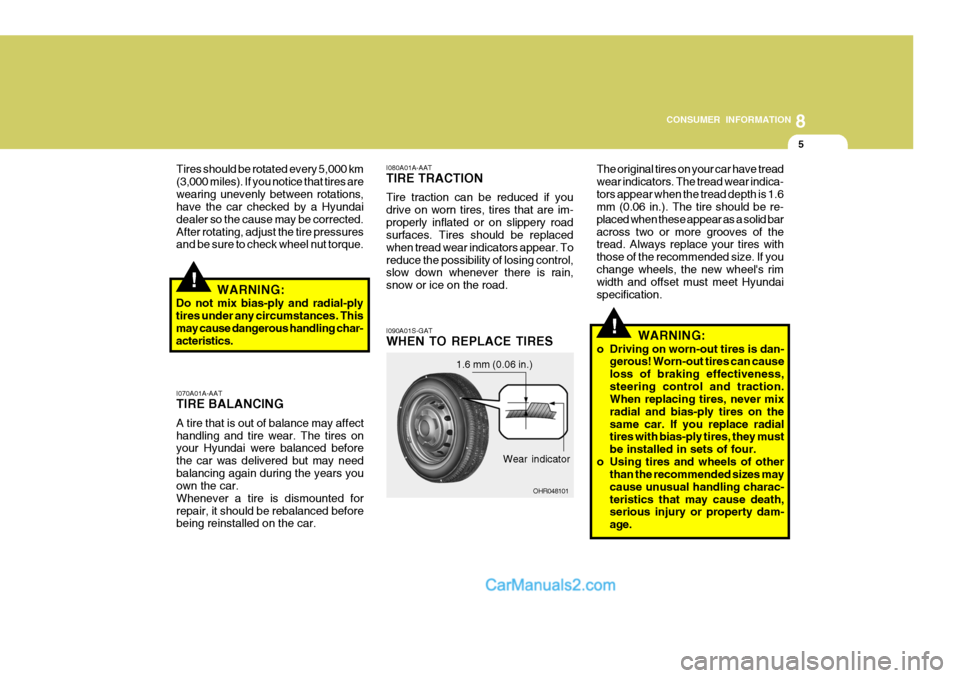
8
CONSUMER INFORMATION
5
!
!
I070A01A-AAT TIRE BALANCING A tire that is out of balance may affect handling and tire wear. The tires on your Hyundai were balanced before the car was delivered but may needbalancing again during the years you own the car. Whenever a tire is dismounted forrepair, it should be rebalanced before
being reinstalled on the car. I080A01A-AAT TIRE TRACTION Tire traction can be reduced if you drive on worn tires, tires that are im-properly inflated or on slippery road surfaces. Tires should be replaced when tread wear indicators appear. Toreduce the possibility of losing control, slow down whenever there is rain, snow or ice on the road. I090A01S-GAT WHEN TO REPLACE TIRES
Tires should be rotated every 5,000 km (3,000 miles). If you notice that tires arewearing unevenly between rotations, have the car checked by a Hyundai dealer so the cause may be corrected.After rotating, adjust the tire pressures and be sure to check wheel nut torque.
WARNING:
Do not mix bias-ply and radial-ply tires under any circumstances. Thismay cause dangerous handling char- acteristics.
Wear indicator
1.6 mm (0.06 in.)
OHR048101 WARNING:
o Driving on worn-out tires is dan- gerous! Worn-out tires can cause loss of braking effectiveness,steering control and traction.
When replacing tires, never mix radial and bias-ply tires on thesame car. If you replace radial tires with bias-ply tires, they must be installed in sets of four.
o Using tires and wheels of other than the recommended sizes maycause unusual handling charac-teristics that may cause death, serious injury or property dam- age.
The original tires on your car have treadwear indicators. The tread wear indica-tors appear when the tread depth is 1.6 mm (0.06 in.). The tire should be re- placed when these appear as a solid baracross two or more grooves of the tread. Always replace your tires with those of the recommended size. If youchange wheels, the new wheel's rim width and offset must meet Hyundai specification.
Page 203 of 217
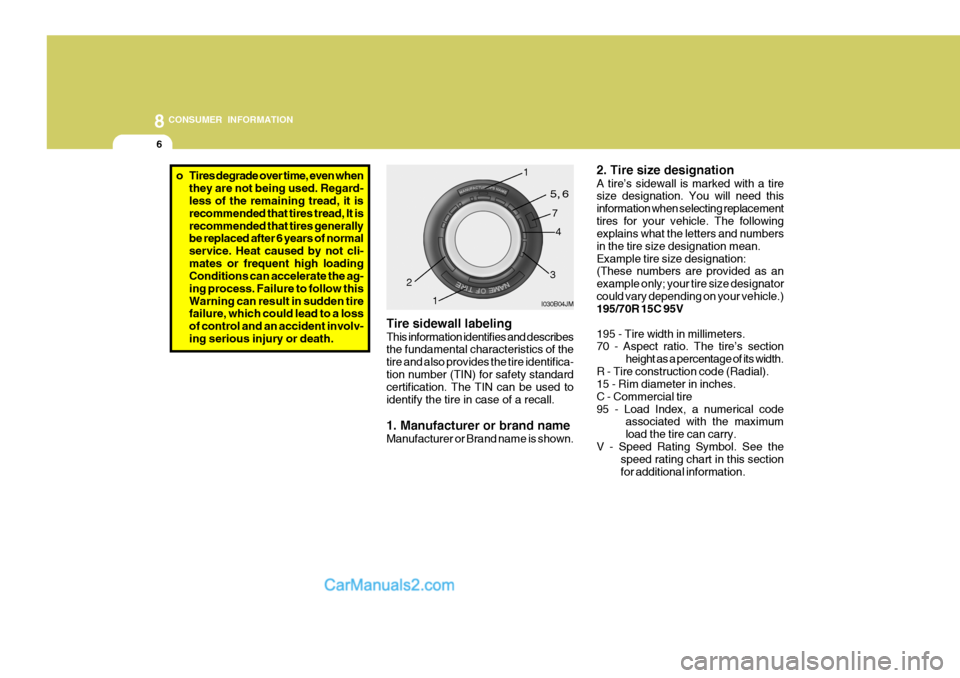
8CONSUMER INFORMATION
6
o Tires degrade over time, even when
they are not being used. Regard- less of the remaining tread, it is recommended that tires tread, It isrecommended that tires generally be replaced after 6 years of normal service. Heat caused by not cli-mates or frequent high loading Conditions can accelerate the ag- ing process. Failure to follow thisWarning can result in sudden tire failure, which could lead to a loss of control and an accident involv-ing serious injury or death. Tire sidewall labeling This information identifies and describes the fundamental characteristics of the tire and also provides the tire identifica-tion number (TIN) for safety standard certification. The TIN can be used to identify the tire in case of a recall. 1. Manufacturer or brand name Manufacturer or Brand name is shown.
I030B04JM
2
1
1
5, 6
7
3
4 2. Tire size designation A tire’s sidewall is marked with a tire size designation. You will need this information when selecting replacementtires for your vehicle. The following explains what the letters and numbers in the tire size designation mean.Example tire size designation: (These numbers are provided as an example only; your tire size designatorcould vary depending on your vehicle.) 195/70R 15C 95V 195 - Tire width in millimeters. 70 - Aspect ratio. The tire’s section
height as a percentage of its width.
R - Tire construction code (Radial).15 - Rim diameter in inches. C - Commercial tire
95 - Load Index, a numerical code associated with the maximumload the tire can carry.
V - Speed Rating Symbol. See the speed rating chart in this sectionfor additional information.
Page 204 of 217
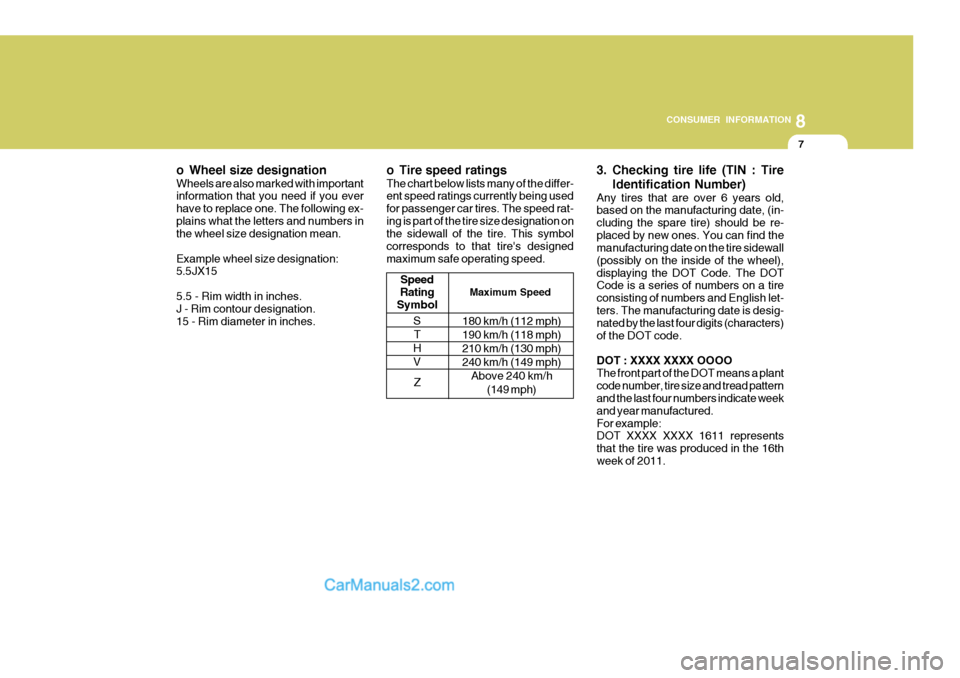
8
CONSUMER INFORMATION
7
o Wheel size designation Wheels are also marked with important information that you need if you ever have to replace one. The following ex-plains what the letters and numbers in the wheel size designation mean. Example wheel size designation:
5.5JX15 5.5 - Rim width in inches. J - Rim contour designation. 15 - Rim diameter in inches. o Tire speed ratings The chart below lists many of the differ- ent speed ratings currently being used for passenger car tires. The speed rat-ing is part of the tire size designation on the sidewall of the tire. This symbol corresponds to that tire's designedmaximum safe operating speed.
3. Checking tire life (TIN : Tire
Identification Number)
Any tires that are over 6 years old, based on the manufacturing date, (in- cluding the spare tire) should be re-placed by new ones. You can find the manufacturing date on the tire sidewall (possibly on the inside of the wheel),displaying the DOT Code. The DOT Code is a series of numbers on a tire consisting of numbers and English let-ters. The manufacturing date is desig- nated by the last four digits (characters) of the DOT code. DOT : XXXX XXXX OOOO The front part of the DOT means a plantcode number, tire size and tread pattern and the last four numbers indicate week and year manufactured.For example: DOT XXXX XXXX 1611 represents that the tire was produced in the 16thweek of 2011.
Speed
Rating
Symbol Maximum Speed
180 km/h (112 mph) 190 km/h (118 mph)210 km/h (130 mph)240 km/h (149 mph)
Above 240 km/h (149 mph)
S
T
HV
Z
Page 205 of 217
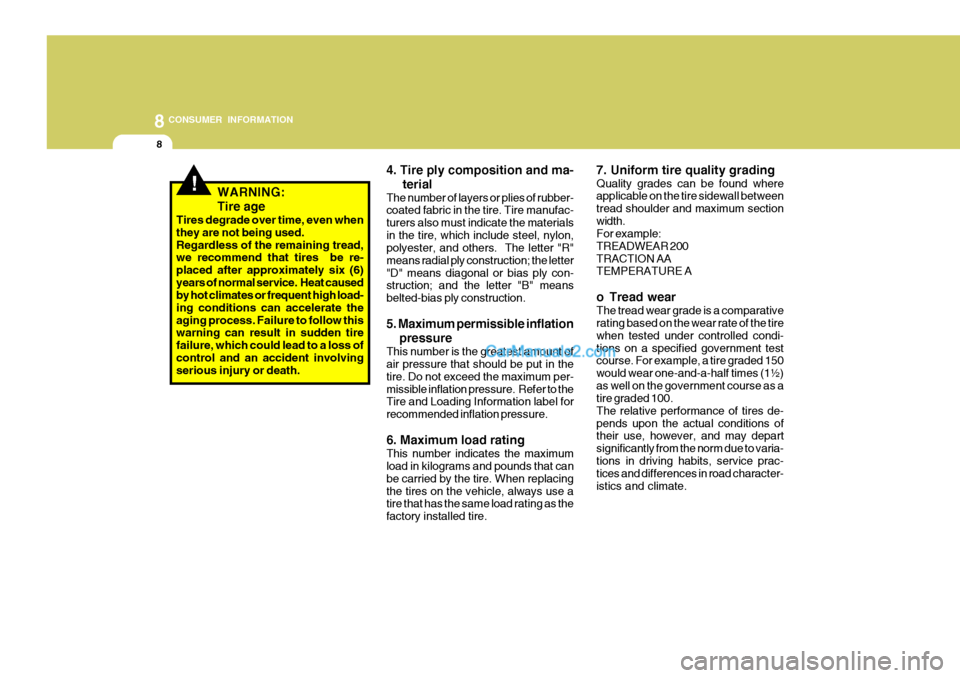
8CONSUMER INFORMATION
8
7. Uniform tire quality grading Quality grades can be found where applicable on the tire sidewall between tread shoulder and maximum sectionwidth. For example: TREADWEAR 200TRACTION AA TEMPERATURE A
o Tread wear The tread wear grade is a comparative rating based on the wear rate of the tire when tested under controlled condi-tions on a specified government test course. For example, a tire graded 150 would wear one-and-a-half times (1½)as well on the government course as a tire graded 100. The relative performance of tires de-pends upon the actual conditions of their use, however, and may depart significantly from the norm due to varia-tions in driving habits, service prac- tices and differences in road character- istics and climate.
!WARNING: Tire age
Tires degrade over time, even when they are not being used.Regardless of the remaining tread, we recommend that tires be re- placed after approximately six (6)years of normal service. Heat caused by hot climates or frequent high load- ing conditions can accelerate theaging process. Failure to follow this warning can result in sudden tire failure, which could lead to a loss ofcontrol and an accident involving serious injury or death. 4. Tire ply composition and ma-
terial
The number of layers or plies of rubber-coated fabric in the tire. Tire manufac- turers also must indicate the materialsin the tire, which include steel, nylon, polyester, and others. The letter "R" means radial ply construction; the letter"D" means diagonal or bias ply con- struction; and the letter "B" means belted-bias ply construction. 5. Maximum permissible inflation
pressure
This number is the greatest amount of air pressure that should be put in the tire. Do not exceed the maximum per-missible inflation pressure. Refer to the Tire and Loading Information label for recommended inflation pressure. 6. Maximum load rating This number indicates the maximum load in kilograms and pounds that can be carried by the tire. When replacingthe tires on the vehicle, always use a tire that has the same load rating as the factory installed tire.
Page 208 of 217
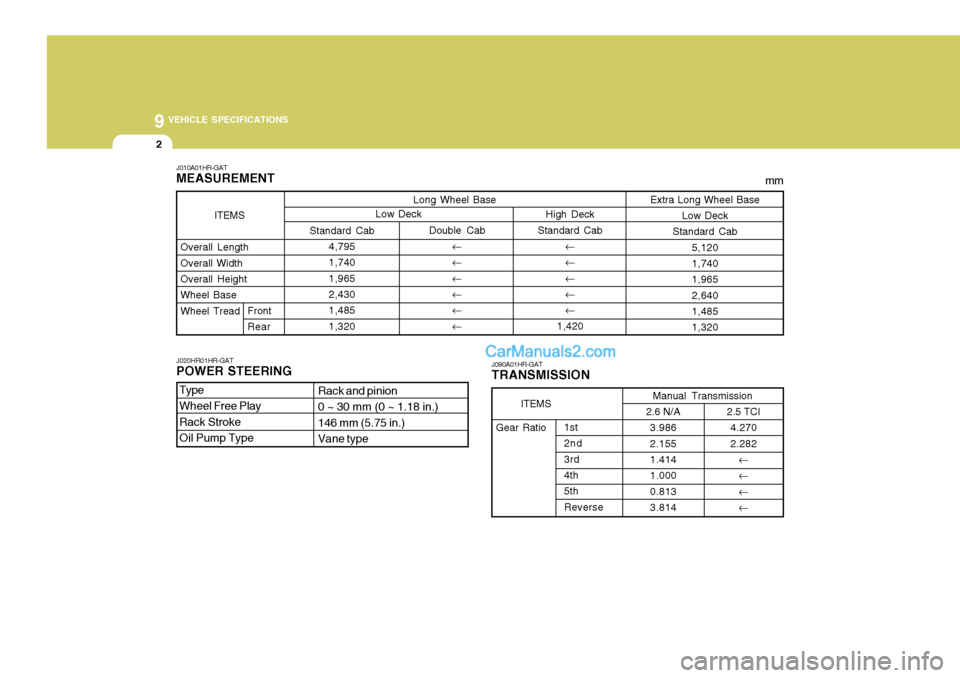
9 VEHICLE SPECIFICATIONS
2
1st 2nd3rd 4th 5thReverse
Double Cab
��� � ��
Standard Cab
4,795 1,740 1,9652,430 1,485 1,320 High Deck
Standard Cab ��� � �
1,420
TypeWheel Free PlayRack Stroke Oil Pump Type
Rack and pinion 0 ~ 30 mm (0 ~ 1.18 in.)146 mm (5.75 in.) Vane type
J020HR01HR-GAT POWER STEERING
Long Wheel Base
Front Rear mm
ITEMS
Overall Length Overall WidthOverall Height Wheel Base Wheel Tread
Extra Long Wheel Base Low Deck
Standard Cab
5,120 1,740 1,965 2,6401,485 1,320
J010A01HR-GAT MEASUREMENT
Low Deck
J090A01HR-GATTRANSMISSION Manual Transmission
2.6 N/A 3.986 2.1551.414 1.000 0.8133.814
ITEMS
Gear Ratio2.5 TCI 4.270 2.282
� � ��